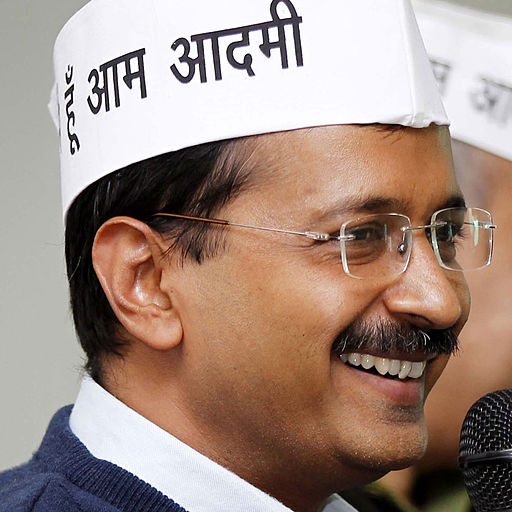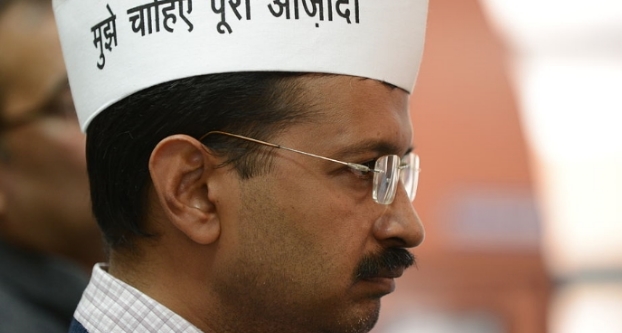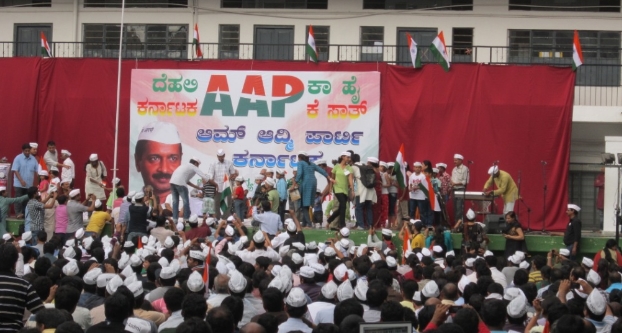Driving commercial and political engagement between Asia, the Middle East and Europe
Driving commercial and political engagement between Asia, the Middle East and Europe
Driving commercial and political engagement between Asia, the Middle East and Europe

It was an unexpected rout. Since May last year, when he led a victorious campaign in India’s parliamentary elections and became prime minister, Narendra Modi and his Bharatiya Janata Party (Indian People’s Party) seemed unstoppable.
After the national elections, four provinces went into polls to elect new governments. In three of those, the BJP won most seats.
Even in the troubled state of Jammu and Kashmir, which has a Muslim majority, the nationalist Hindu BJP did well enough outside the core Muslim areas to emerge as a contender for power. (In the Jammu and Kashmir Legislative Assembly elections held in November and December last year, the BJP emerged as second-largest party by winning 25 seats with a vote share of 23 per cent, the highest for any party in the state. Since the PDP, which won 28 seats, also fell short of a majority in the house of 87, the BJP and PDP are currently in talks to create an alliance and form a government to rule the state.)
Then, on February 7, the elections for the state assembly in the national capital region of Delhi took place. The BJP wound up with three seats in the house of 70. The Congress party led by Sonia and Rahul Gandhi ended up with zero. An astonishing 67 of the 70 seats was won by the Aam Aadmi Party (Common Man’s Party known as AAP) led by former tax inspector Arvind Kejriwal.
The sheer scale of the victory was described by Mr Kejriwal himself as “scary”. Responses to it ranged from wonder to worry to wicked humour. Supporters of the Congress, which had been wiped out, took solace in the plight of the BJP, and vice versa. Leaders of both defeated parties promised they would introspect.
The whole country has already done a lot of thinking and talking for them. Every analyst and columnist in the country has given his or her diagnosis. So too has everyone across the political spectrum.

Aam Aadmi Party Leader and Chief Minister of Delhi Arvind Kejriwal. Photo By ThinkingYouth via Wikimedia Commons
The victorious Mr Kejriwal’s explanation is that the Congress and the BJP had lost due to their arrogance. He has warned his own party workers to remain humble.
This is an interesting diagnosis. Its immediate triggers may flow from the brouhaha over Mr Modi sporting a suit (allegedly worth nearly Rs 10 lakh or £10,000) with his name on it during a meeting with Mr Barack Obama in Delhi in January. However, knowingly or unwittingly, Mr Kejriwal may have hit upon one of the deep, hidden weaknesses of both the Congress and the BJP. To understand that, a little bit of background is essential.
Family histories
The Congress is the grand old party of India. It was founded in 1885 by Allan Hume and led India’s freedom struggle. Mahatma Gandhi, Jawaharlal Nehru, Vallabhbhai Patel, BR Ambedkar, Pakistan founder Muhammad Ali Jinnah and the militant leader of the Indian National Army Subhas Chandra Bose were among its prominent leaders. The party has ruled India for more than 50 of its 67 years as a free country.
The BJP, which began existence as the Bharatiya Jan Sangh in 1951, was founded by the Rashtriya Swayamsevak Sangh, a nationalist Hindu organisation. Its growth was slow until the 1989 elections, when it suddenly surged from two seats to 85. It grew rapidly from there on and in 1996 the BJP formed its first government at the centre as the largest grouping in an alliance led by Atal Bihari Vajpayee. That government lasted only 13 days, but since then, the politics of India at the national level has been a battle between the United Progressive Alliance led by the Congress, and the National Democratic Alliance led by the BJP.
The NDA (a coalition of political parties led by the BJP) ruled India under Atal Bihari Vajpayee’s leadership between 1998 and 1999 and again from 1999 to 2004. This current government under Modi is India’s third NDA government though the BJP has enough seats in Parliament – for the first time ever – to not need allies.
The dividing line between the two alliances was the principle of secularism, meant here not in the Western sense of the word, but in an Indian way that stresses on equal treatment of faiths rather than their elimination from public life. The Congress has long been a votary of secularism, while the BJP, an overtly Hindu party, has consistently accused it of “pseudo-secularism”.
In truth, no one was really working at equal treatment. The Congress and its allies drew their support by extending special patronage to combinations of certain castes and communities. Thus equations would be worked out, with acronyms such as MY for Muslim and Yadav, KHAM for Kshatriya, Harijan, Adivasi and Muslim, and so on. These groups, which were mainly traditionally backward castes or religious minorities, would be built into ‘vote banks’ by favouring them over others.
Most of these equations tended to leave out the upper caste Hindus, who naturally gravitated towards the BJP, especially after a policy of affirmative action in education and jobs for the lower castes was expanded in 1989 – the year the BJP leapt from two seats to 85. The election that year was dominated by the issue of corruption, and targeted the Congress party.
As voters looked for alternatives to the Congress, the core political bases got divided with different social groups going different ways. The political competition added a fresh layer of antagonism to pre-existing social differences and ancient grudges.
Pride and prejudice
Through all this, the leadership of the Congress remained firmly with the family of first Prime Minister Jawaharlal Nehru. The prominent leaders of the party even outside the family were largely men and women who came from the old, Westernised liberal elite aristocracy of India. Its leaders tended to have Oxbridge educations or princely titles, or both. It was feudal in its own kindly way; the British Raj enjoyed an extended sunset under its rule.
The BJP represented the Hindu traditionalists who were keen to reassert Hindu culture after what they saw as a thousand years of foreign rule. They, too, represented another kind of elite – the ancient Hindu caste elite.
There was a natural arrogance in both these groups, and this arrogance only increased with political success.
Even today, in India, the liberal elites who were traditional Congress supporters are largely ignorant of their own languages and culture. Most of them speak Indian languages only to their servants. They typically do not, and cannot, read or write in their own languages. Their attitudes, like their Lutyens’ Delhi lifestyles, (referring to the British architect Sir Edwin Landseer Lutyens who designed and built much of New Delhi including Rashtrapati Bhavan) is a throwback to colonial days. Sophistication in these circles is still measured by adherence to Western standards and fashions.
In this, they are unlike the vast majority of their countrymen and women, who are not rich enough to be ‘global Indians’, and hence remain local Indians.
The caste Hindu elite (represented by the BJP) with its assertion of past glories and its tendency to see ancient India as the pinnacle of human civilization has been prone to another kind of error. It tended to look down on other ‘lower’ castes, on adherents of other faiths, and on the aboriginal tribes of India. Naturally, this won it no friends among those groups, and certainly didn’t help in bridging social divides. It also tended to dream of a return to ancient glory, with every achievement by anyone with a remotely Hindu name and brown skin being celebrated as a sign of impending greatness.
During the first full tenure of the BJP government at the centre from 1998 to 2004, this fed into the rhetoric of India as an emerging superpower. The hubris, mixed with complacence, likely cost the BJP the national elections of 2004. That year, the BJP ran on a campaign of ‘India Shining’. It was widely expected to win, but even though its overall vote share in percentage terms remained almost unchanged, it lost a lot of seats as it finished second in many constituencies.
Humble winner takes all
The vagaries of India’s ‘first-past-the-post’ electoral system mean that a lot of votes scattered across electoral constituencies are useless. Say your country has 10 athletes running in the finals in 10 different races that give only gold medals. Winner takes all in these races. Obviously, merely doing well is pointless, since if they don’t finish first, there’s no medal. Another country with only one person running the finals who wins the race will be better off. That’s how it works in Indian elections.
In the 2014 national parliament elections, the BJP vote share in Delhi was 46 percent, up from 33 percent in the Delhi Assembly Elections of 2013 that the AAP had narrowly won. The BJP won all seven parliamentary seats in Delhi in 2014. The AAP, which polled 32.9 percent of the vote, drew a blank as it finished second everywhere. Now in 2015, the BJP was back to 32 percent in the Delhi Assembly Elections. But it lost 67 of 70 assembly seats. It’s clear that the party held on to its voters, but that was only good enough for it to finish second almost everywhere as the AAP increased its share of the vote to 54.3 percent.
The Congress candidates were wiped out. Under Rahul Gandhi, the party’s leadership looks remote. It is disconnected from the Indian masses, and nothing like them.
The BJP under Modi, the party’s first backward caste leader of note (according to the Indian caste system), a man who rose from very humble beginnings, had started its innings at the centre with a deep grassroots connect. However, Mr Modi has now begun to appear distant as well. His speeches have become familiar, and no longer evoke the excitement they used to. During the BJP’s Delhi Assembly Election 2015 campaign, a photo of his own party’s local leaders dozing on stage while he gave a campaign speech went viral.
Mr Kejriwal has been able to provide a contrast to both Mr Gandhi and Mr Modi. He is ostentatiously humble. A small man, he dresses and looks like the average Delhiite.

Aam Aadmi Party Leader Arvind Kejriwal. Photo by ThinkingYouth via Wikimedia Commons
There is a still a freshness about him and his politics. He and the AAP seem sincere and honest. Their main promises are about cheap electricity and water, an end to the petty corruption that hits the common man in India, and affordable education and health care. During their previous stint running the Delhi state government that lasted only 49 days, they had cracked down hard on corruption, and moved militantly to reduce electricity bills. The electorate clearly approved of those actions and wants more of the same.
It is easy to forget, somehow, that India is still overwhelmingly a country of poor people. Economists have complicated the issue so much with their arcane debates that it is nigh impossible to figure what proportion of the country actually lives in poverty. However, if we look only at Delhi (which has the highest per capita income in India) the National Sample Survey Organisation of India’s latest publicly available data from 2011-12 reveals that 60 percent of households had monthly incomes of Rs 13,500 a month (£141) or less. A household in India usually means at least four people, and usually more. So that’s an income of about £35 per person per month, or less. It is no surprise that a party that actually seems serious about addressing the concerns of these people has finally emerged, and done well.
Going ahead, the AAP will have its task cut out delivering on its promises. Its performance in Delhi will be crucial to its future as a national party. It will also face multiple challenges in trying to expand beyond Delhi. The first of these will be in deciding how and when it wants to expand. Mr Kejriwal has spoken of remaining focused on Delhi for now, while the party’s strategist Yogendra Yadav is clear that he sees AAP emerging as a ‘nationwide force for alternative politics.’

Arvind Kejriwal in Bangalore at the inauguration of the Aam Aadmi Party Karnataka. Photo by DelhiiteRock via Wikimedia Commons
The Congress is in free fall, and the Left has all but disappeared from the national scene. Other opposition parties are regional in character. There is therefore adequate political space for a national party that stands up for the common man. However, the BJP’s strength at the national level is undiminished. Its government at the centre is stable and enjoys a comfortable majority. Therefore, national policies are unlikely to be directly affected by the AAP’s rise in the near term.
The BJP has not lost its political support at the national level and is likely to continue its march in states of India where it did not previously have a significant presence, such as West Bengal and Assam in the east of the country, both of which will elect new state assembly members in 2016. The BJP has recently swept the municipal elections in Assam for the first time. It may not do as well in Bihar, where elections are due later this year, but neither will the Congress. The AAP does not plan to contest the Bihar elections.
If the AAP chooses to expand, it will also have to battle with the regional forces in their own backyards. Its growth prospects are therefore brighter in parts of India where the polity is largely bipolar, divided between the Congress and the BJP. Its stellar performance in Delhi came in such a contest. The AAP is therefore expected to make forays into Punjab, where it won all its four Parliamentary seats, and possibly into Gujarat, which has not seen a robust opposition to the BJP in decades.
My hunch is that the party, if it endures, will eventually move to occupy the left of centre political space in the country.
The AAP is very clear that it does not believe in leftist dogma, but as Mr Yadav said in a recent interview to the The Economic Times in India, “I do not know of any single civilized state that does not seek to secure conditions of education or decent health for its citizens”. His party, he said, practises, “class politics without the ideology of class struggle and without the doctrine of state being the only instrument”.
Clearly, there are many takers for that.
Samrat Choudhury is the editor of The Asian Age, Mumbai. In his 16 years as a journalist, he has worked with major newspapers and news magazines in all parts of India. His writings have appeared in publications including the Hindustan Times, The Times of India, India Today, Caravan, The New York Times, The Friday Times of Pakistan, and the Dhaka Tribune of Bangladesh. He is the author of several short stories and a novel, The Urban Jungle Book, which was published by Penguin in 2011.
He can be found on Twitter as @mrsamratx
